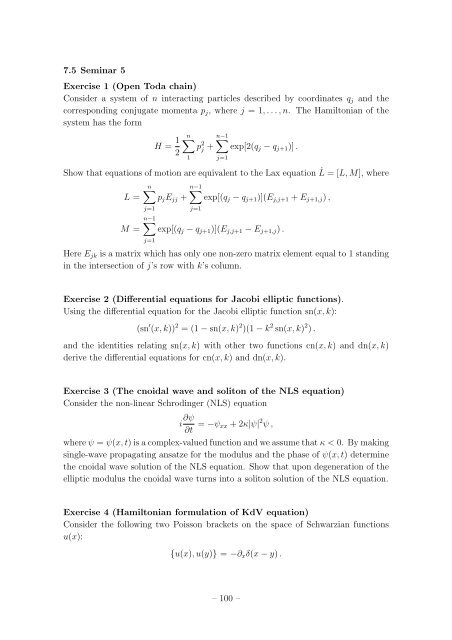Student Seminar: Classical and Quantum Integrable Systems
Student Seminar: Classical and Quantum Integrable Systems
Student Seminar: Classical and Quantum Integrable Systems
You also want an ePaper? Increase the reach of your titles
YUMPU automatically turns print PDFs into web optimized ePapers that Google loves.
7.5 <strong>Seminar</strong> 5<br />
Exercise 1 (Open Toda chain)<br />
Consider a system of n interacting particles described by coordinates q j <strong>and</strong> the<br />
corresponding conjugate momenta p j , where j = 1, . . . , n. The Hamiltonian of the<br />
system has the form<br />
H = 1 n∑ ∑n−1<br />
p 2 j + exp[2(q j − q j+1 )] .<br />
2<br />
1<br />
j=1<br />
Show that equations of motion are equivalent to the Lax equation ˙L = [L, M], where<br />
n∑ ∑n−1<br />
L = p j E jj + exp[(q j − q j+1 )](E j,j+1 + E j+1,j ) ,<br />
j=1<br />
j=1<br />
∑n−1<br />
M = exp[(q j − q j+1 )](E j,j+1 − E j+1,j ) .<br />
j=1<br />
Here E jk is a matrix which has only one non-zero matrix element equal to 1 st<strong>and</strong>ing<br />
in the intersection of j’s row with k’s column.<br />
Exercise 2 (Differential equations for Jacobi elliptic functions).<br />
Using the differential equation for the Jacobi elliptic function sn(x, k):<br />
(sn ′ (x, k)) 2 = (1 − sn(x, k) 2 )(1 − k 2 sn(x, k) 2 ) .<br />
<strong>and</strong> the identities relating sn(x, k) with other two functions cn(x, k) <strong>and</strong> dn(x, k)<br />
derive the differential equations for cn(x, k) <strong>and</strong> dn(x, k).<br />
Exercise 3 (The cnoidal wave <strong>and</strong> soliton of the NLS equation)<br />
Consider the non-linear Schrodinger (NLS) equation<br />
i ∂ψ<br />
∂t = −ψ xx + 2κ|ψ| 2 ψ ,<br />
where ψ = ψ(x, t) is a complex-valued function <strong>and</strong> we assume that κ < 0. By making<br />
single-wave propagating ansatze for the modulus <strong>and</strong> the phase of ψ(x, t) determine<br />
the cnoidal wave solution of the NLS equation. Show that upon degeneration of the<br />
elliptic modulus the cnoidal wave turns into a soliton solution of the NLS equation.<br />
Exercise 4 (Hamiltonian formulation of KdV equation)<br />
Consider the following two Poisson brackets on the space of Schwarzian functions<br />
u(x):<br />
{u(x), u(y)} = −∂ x δ(x − y) .<br />
– 100 –

















